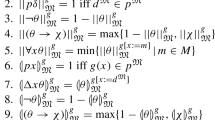Abstract
Every language recognized by the Lambek calculus with brackets is context-free. This is shown by combining an observation by Jäger with an entirely straightforward adaptation of the method Pentus used for the original Lambek calculus. The case of the variant of the calculus allowing sequents with empty antecedents is slightly more complicated, requiring a restricted use of the multiplicative unit.
Similar content being viewed by others
Notes
Equivalently, we may take all sequents of the form \(A {\varvec{\rightarrow }}A\) as initial sequents, as Jäger (2003) did.
This is one of the two notions of recognition studied by Jäger (2003); he called this notion t-recognition.
An example (adapted from Fadda and Morrill 2005) is \(\Diamond \Box ^{\downarrow }p \,\Diamond \Box ^{\downarrow }q {\varvec{\rightarrow }}\Diamond \Box ^{\downarrow }(p \bullet q)\).
See Kanazawa (2006) for a statement of an interpolation theorem for the implicational fragment of intuitionistic logic in terms of these links.
To extend Moortgat’s (1996) proof in the presence of \(\varvec{1}\), one only need to add the reduction step

Pentus’s (1999) claim of context-freeness of \(\mathbf {L}^{\textstyle *}\), as opposed to \(\mathbf {L}^{\textstyle *}_{\varvec{1}}\), is immune to this criticism since an interpolation theorem similar to Theorem 3 does hold for \(\mathbf {L}^{\textstyle *}\) and there’s no need to use \(\varvec{1}\) in converting an \(\mathbf {L}^{\textstyle *}\) grammar to a context-free grammar. The same criticism does apply to his claim about grammars based on multiplicative cyclic linear logic (CLL).
References
Fadda, M., & Morrill, G. (2005). The Lambek calculus with brackets. In C. Casadio, P. J. Scott, & R. A. Seely (Eds.), Language and grammar: Studies in mathematical linguistics and natural language (pp. 113–128). Stanford, CA: CSLI Publications.
Jäger, G. (2003). On the generative capacity of multi-modal categorial grammars. Research on Language and Computation, 1(1), 105–125. https://doi.org/10.1023/A:1024512212054.
Kanazawa, M. (2006). Computing interpolants in implicational logics. Annals of Pure and Applied Logics, 142(1–3), 125–201. https://doi.org/10.1016/j.apal.2005.12.014.
Kanovich, M., Kuznetsov, S., Morrill, G., & Scedrov, A. (2017). A polynomial-time algorithm for the Lambek calculus with brackets of bounded order. In D. Miller (Ed.), 2nd international conference on formal structures for computation and deduction (FSCD 2017), Schloss Dagstuhl–Leibniz-Zentrum fuer Informatik, Dagstuhl, Germany, leibniz international proceedings in informatics (LIPIcs), vol 84, (pp. 22:1–22:17). https://doi.org/10.4230/LIPIcs.FSCD.2017.22, URL http://drops.dagstuhl.de/opus/volltexte/2017/7738.
Kuznetsov, S. (2012). Lambek grammars with the unit. In P. de Groote, & M. J. Nederhof (Eds.), Formal grammar: 15th and 16th international conferences, FG 2010, Copenhagen, Denmark, August 2010, FG 2011, Ljubljana, Slovenia, August 2011, Revised Selected Papers (pp. 262–266). Berlin, Heidelberg: Springer Berlin Heidelberg. https://doi.org/10.1007/978-3-642-32024-8_17.
Lambek, J. (1958). The mathematics of sentence structure. American Mathematical Monthly, 65, 154–170.
Lambek, J. (1961). On the calculus of syntactic types. In R. Jakobson (Ed.), Structure of language and its mathematical aspects (pp. 166–178). Providence, R.I.: American Mathematical Society.
Moortgat, M. (1996). Multimodal linguistic inference. Journal of Logic, Language, and Information, 5, 349–385.
Pentus, M. (1993). Lambek grammars are context free. In Proceedings of the eighth annual IEEE symposium on logic in computer science (pp. 429–433).
Pentus, M. (1997). Product-free Lambek calculus and context-free grammars. Journal of Symbolic Logic, 62, 648–660.
Pentus, M. (1999). Lambek calculus and formal grammars. In Provability, complexity, grammars, no. 192 in American mathematical society translations–series 2 (pp. 57–86). Providence, Rhode Island: American Mathematical Society.
Roorda, D. (1991). Resource logics: Proof-theoretical investigations. PhD thesis, University of Amsterdam.
Versmissen, J. A. G. (1996). Grammatical composition: Modes, models, modalities. PhD thesis, University of Utrecht.
Author information
Authors and Affiliations
Corresponding author
Rights and permissions
About this article
Cite this article
Kanazawa, M. On the Recognizing Power of the Lambek Calculus with Brackets. J of Log Lang and Inf 27, 295–312 (2018). https://doi.org/10.1007/s10849-018-9269-3
Published:
Issue Date:
DOI: https://doi.org/10.1007/s10849-018-9269-3





